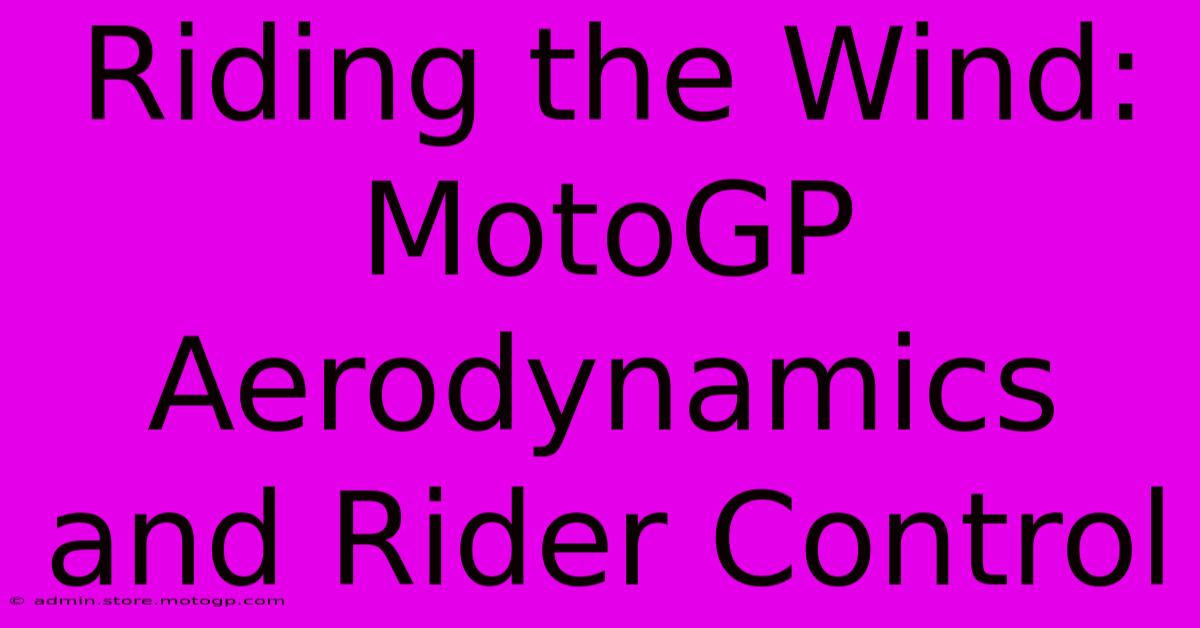Riding The Wind: MotoGP Aerodynamics And Rider Control

Table of Contents
Riding the Wind: MotoGP Aerodynamics and Rider Control
MotoGP racing isn't just about raw horsepower; it's a delicate dance between rider skill and machine performance, with aerodynamics playing a pivotal role. Modern MotoGP bikes are marvels of engineering, generating downforce comparable to Formula 1 cars, significantly impacting rider control, stability, and ultimately, race results. This article dives deep into the fascinating world of MotoGP aerodynamics and how it empowers riders to push the limits.
The Science of Speed: Understanding MotoGP Aerodynamics
MotoGP bikes aren't designed to simply slice through the air; they're engineered to use the air to their advantage. Sophisticated aerodynamic components, including:
-
Winglets: These small wings, often found on the fairing and near the swingarm, generate downforce, pressing the front and rear wheels firmly to the track. This increases traction, especially during cornering and braking, allowing for faster corner speeds and shorter braking distances.
-
Fairings: The streamlined bodywork minimizes drag while maximizing downforce. The shape and design are constantly refined through Computational Fluid Dynamics (CFD) simulations and wind tunnel testing. Every curve and angle is crucial in optimizing airflow.
-
Underbody Aerodynamics: This often-overlooked aspect plays a critical role. The design of the underbody channels airflow, creating a low-pressure zone that sucks the bike towards the track surface, further enhancing stability and grip.
-
Air Intake and Exhaust: These elements are not solely for engine functionality; they also significantly impact airflow around the bike, contributing to overall aerodynamic efficiency.
The Aerodynamic Balancing Act: Downforce vs. Drag
The key challenge is finding the optimal balance between downforce and drag. More downforce means better grip and faster cornering, but it also means increased drag, slowing the bike down on the straights. Teams constantly tweak their aerodynamic setup to find the sweet spot for each track's unique characteristics. A track with many tight corners might prioritize downforce, while a track with long straights will require a setup that minimizes drag.
Rider Control: The Human Element in Aerodynamic Performance
While the technology is impressive, the rider is the crucial element that brings it all together. A skilled MotoGP rider needs to understand how the aerodynamics of the bike affect its behavior under various conditions:
-
Braking: The increased downforce provides exceptional braking stability, allowing riders to brake later and harder into corners. However, too much downforce can make the bike unpredictable at the limit.
-
Cornering: Aerodynamic downforce allows riders to carry incredible speed through corners. The rider must be adept at managing the bike's behavior, feeling the subtle changes in grip and reacting accordingly.
-
Acceleration: While downforce aids cornering, it increases drag, affecting acceleration. Riders need to skillfully modulate the throttle and manage the bike's power delivery to optimize speed.
-
Overtaking: The aerodynamic interaction between bikes is a crucial factor in overtaking maneuvers. A rider might use the slipstream of another bike to gain speed and then use superior aerodynamic control to make the decisive pass.
The Future of MotoGP Aerodynamics
The pursuit of aerodynamic excellence in MotoGP is a continuous evolution. We can expect to see further refinement of existing techniques and potentially the introduction of new technologies, such as active aerodynamic elements that adjust in real time to optimize performance in different conditions. This might include adjustable wings or fairings that dynamically change shape based on speed and track conditions.
Conclusion: A Symphony of Speed and Control
MotoGP aerodynamics is a fascinating blend of science, engineering, and rider skill. It's not just about creating fast bikes; it's about creating bikes that are controllable, predictable, and ultimately, capable of delivering breathtaking racing performances. As technology continues to evolve, the dance between the machine and the rider will remain the heart of MotoGP's enduring appeal. The battle for aerodynamic supremacy continues to push the boundaries of speed and precision, resulting in a spectacle of thrilling races that captivate audiences worldwide.

Thank you for visiting our website wich cover about Riding The Wind: MotoGP Aerodynamics And Rider Control. We hope the information provided has been useful to you. Feel free to contact us if you have any questions or need further assistance. See you next time and dont miss to bookmark.
Featured Posts
-
F1 Us Grand Prix Watch The Podium Ceremony Live On Tv
Feb 20, 2025
-
Moto Gp Top Speed Pushing Boundaries
Feb 20, 2025
-
Sprint Races Adding Excitement To Every Moto Gp Weekend
Feb 20, 2025
-
Cota Parking Map Insider Tips And Tricks
Feb 20, 2025
-
Cota Parking Secrets Unveiled In This Map
Feb 20, 2025
